The Own-Race Bias Effect and the Effects of Happy Facial Expressions during Face Recognition
VerifiedAdded on 2023/06/08
|12
|3507
|67
AI Summary
This study explores the effect of own-race bias in facial recognition in Singaporean people and the outcomes of such behaviors. It also examines the effects of happy facial expressions during face recognition. The experiment used data obtained from 68 participants and concluded that people have better memories of the images of those who hail from similar races as themselves, while a short memory for other races.
Contribute Materials
Your contribution can guide someone’s learning journey. Share your
documents today.
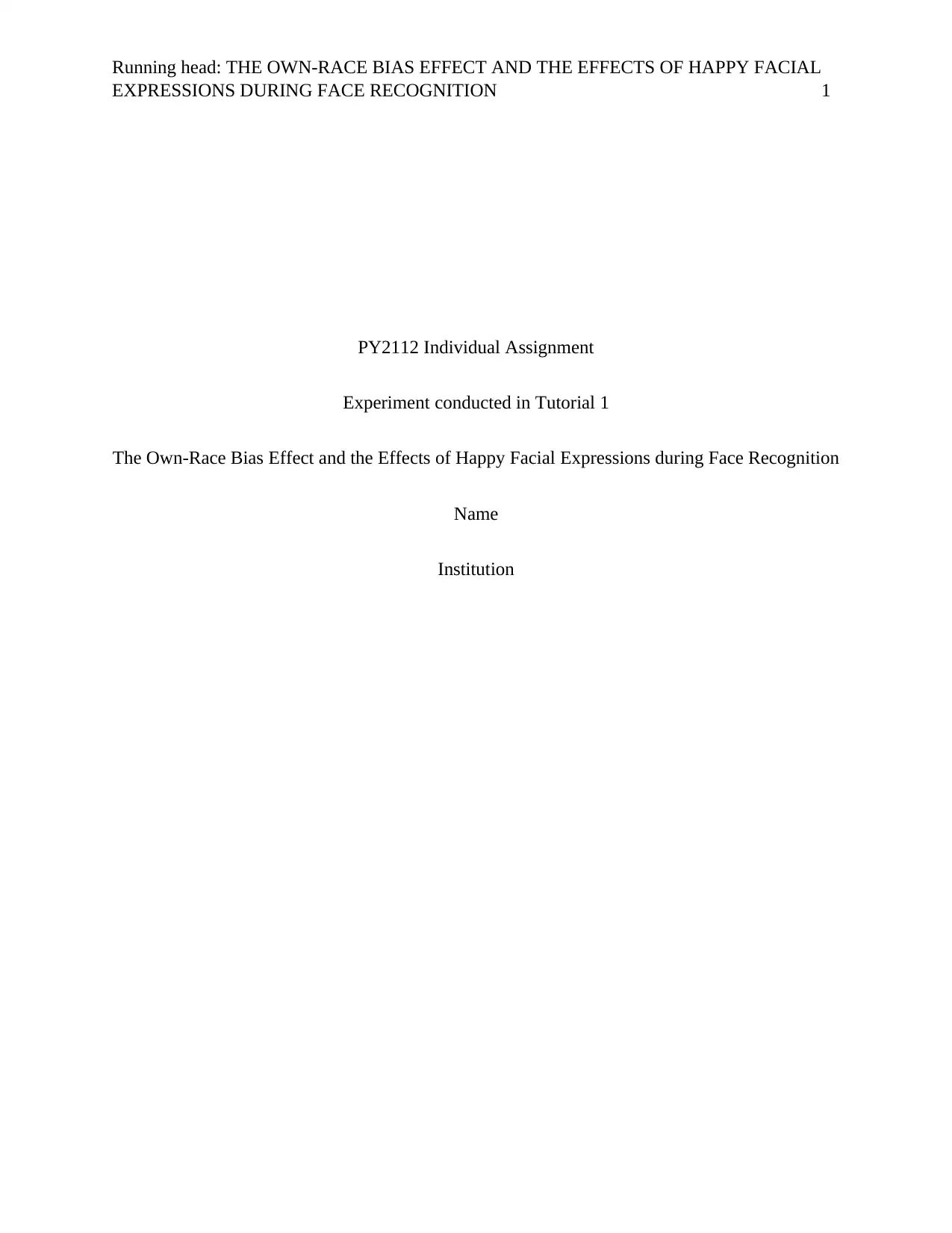
Running head: THE OWN-RACE BIAS EFFECT AND THE EFFECTS OF HAPPY FACIAL
EXPRESSIONS DURING FACE RECOGNITION 1
PY2112 Individual Assignment
Experiment conducted in Tutorial 1
The Own-Race Bias Effect and the Effects of Happy Facial Expressions during Face Recognition
Name
Institution
EXPRESSIONS DURING FACE RECOGNITION 1
PY2112 Individual Assignment
Experiment conducted in Tutorial 1
The Own-Race Bias Effect and the Effects of Happy Facial Expressions during Face Recognition
Name
Institution
Secure Best Marks with AI Grader
Need help grading? Try our AI Grader for instant feedback on your assignments.
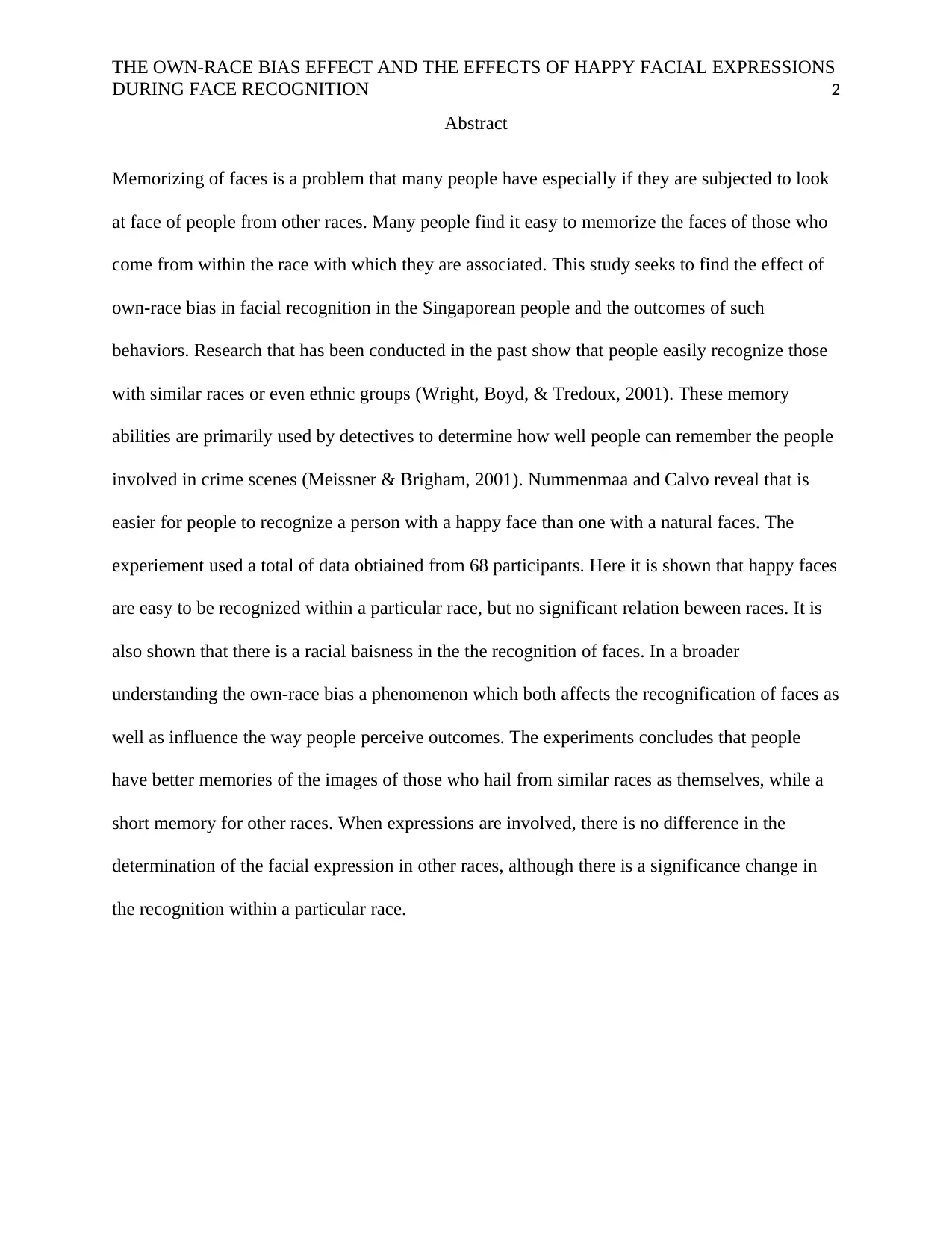
THE OWN-RACE BIAS EFFECT AND THE EFFECTS OF HAPPY FACIAL EXPRESSIONS
DURING FACE RECOGNITION 2
Abstract
Memorizing of faces is a problem that many people have especially if they are subjected to look
at face of people from other races. Many people find it easy to memorize the faces of those who
come from within the race with which they are associated. This study seeks to find the effect of
own-race bias in facial recognition in the Singaporean people and the outcomes of such
behaviors. Research that has been conducted in the past show that people easily recognize those
with similar races or even ethnic groups (Wright, Boyd, & Tredoux, 2001). These memory
abilities are primarily used by detectives to determine how well people can remember the people
involved in crime scenes (Meissner & Brigham, 2001). Nummenmaa and Calvo reveal that is
easier for people to recognize a person with a happy face than one with a natural faces. The
experiement used a total of data obtiained from 68 participants. Here it is shown that happy faces
are easy to be recognized within a particular race, but no significant relation beween races. It is
also shown that there is a racial baisness in the the recognition of faces. In a broader
understanding the own-race bias a phenomenon which both affects the recognification of faces as
well as influence the way people perceive outcomes. The experiments concludes that people
have better memories of the images of those who hail from similar races as themselves, while a
short memory for other races. When expressions are involved, there is no difference in the
determination of the facial expression in other races, although there is a significance change in
the recognition within a particular race.
DURING FACE RECOGNITION 2
Abstract
Memorizing of faces is a problem that many people have especially if they are subjected to look
at face of people from other races. Many people find it easy to memorize the faces of those who
come from within the race with which they are associated. This study seeks to find the effect of
own-race bias in facial recognition in the Singaporean people and the outcomes of such
behaviors. Research that has been conducted in the past show that people easily recognize those
with similar races or even ethnic groups (Wright, Boyd, & Tredoux, 2001). These memory
abilities are primarily used by detectives to determine how well people can remember the people
involved in crime scenes (Meissner & Brigham, 2001). Nummenmaa and Calvo reveal that is
easier for people to recognize a person with a happy face than one with a natural faces. The
experiement used a total of data obtiained from 68 participants. Here it is shown that happy faces
are easy to be recognized within a particular race, but no significant relation beween races. It is
also shown that there is a racial baisness in the the recognition of faces. In a broader
understanding the own-race bias a phenomenon which both affects the recognification of faces as
well as influence the way people perceive outcomes. The experiments concludes that people
have better memories of the images of those who hail from similar races as themselves, while a
short memory for other races. When expressions are involved, there is no difference in the
determination of the facial expression in other races, although there is a significance change in
the recognition within a particular race.
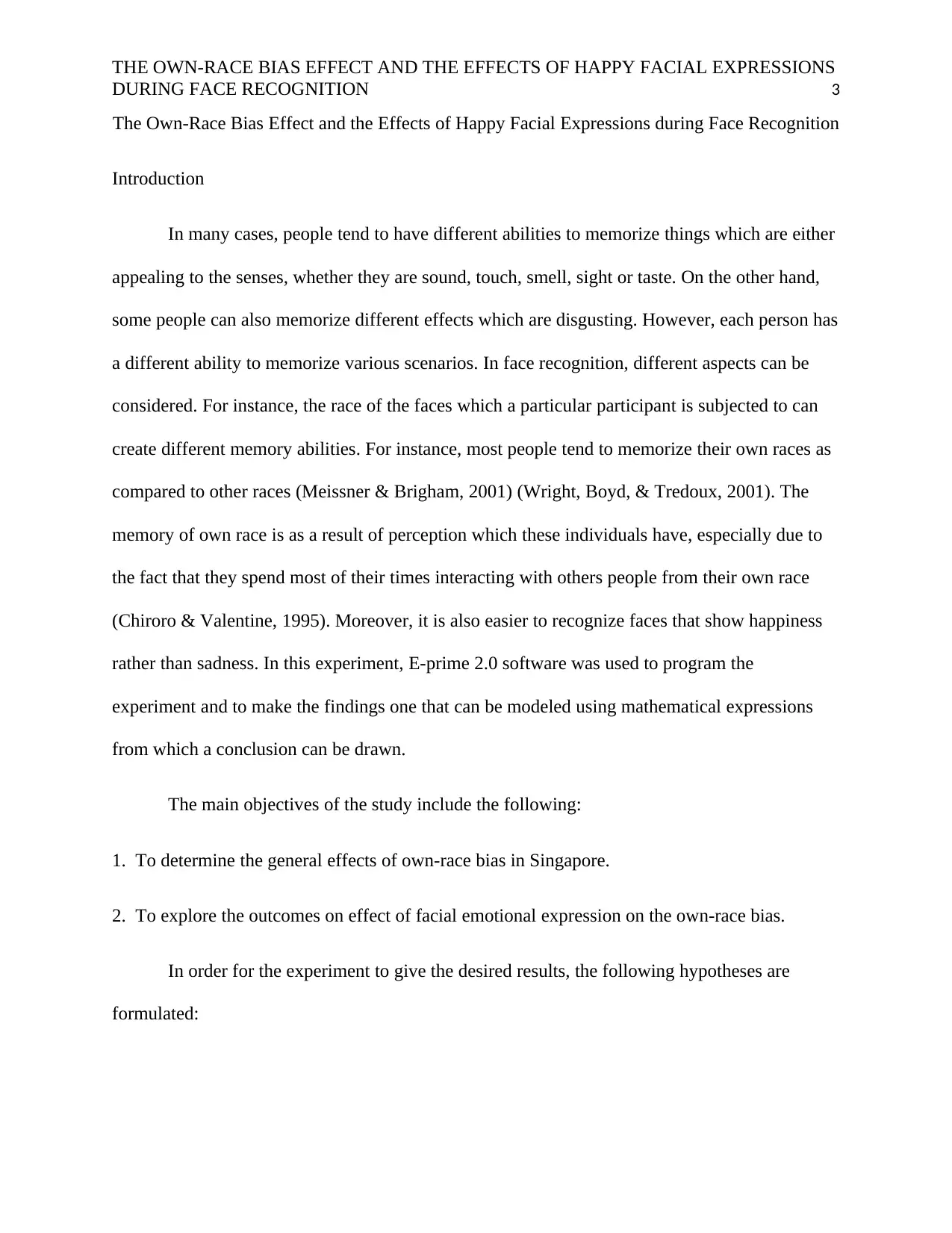
THE OWN-RACE BIAS EFFECT AND THE EFFECTS OF HAPPY FACIAL EXPRESSIONS
DURING FACE RECOGNITION 3
The Own-Race Bias Effect and the Effects of Happy Facial Expressions during Face Recognition
Introduction
In many cases, people tend to have different abilities to memorize things which are either
appealing to the senses, whether they are sound, touch, smell, sight or taste. On the other hand,
some people can also memorize different effects which are disgusting. However, each person has
a different ability to memorize various scenarios. In face recognition, different aspects can be
considered. For instance, the race of the faces which a particular participant is subjected to can
create different memory abilities. For instance, most people tend to memorize their own races as
compared to other races (Meissner & Brigham, 2001) (Wright, Boyd, & Tredoux, 2001). The
memory of own race is as a result of perception which these individuals have, especially due to
the fact that they spend most of their times interacting with others people from their own race
(Chiroro & Valentine, 1995). Moreover, it is also easier to recognize faces that show happiness
rather than sadness. In this experiment, E-prime 2.0 software was used to program the
experiment and to make the findings one that can be modeled using mathematical expressions
from which a conclusion can be drawn.
The main objectives of the study include the following:
1. To determine the general effects of own-race bias in Singapore.
2. To explore the outcomes on effect of facial emotional expression on the own-race bias.
In order for the experiment to give the desired results, the following hypotheses are
formulated:
DURING FACE RECOGNITION 3
The Own-Race Bias Effect and the Effects of Happy Facial Expressions during Face Recognition
Introduction
In many cases, people tend to have different abilities to memorize things which are either
appealing to the senses, whether they are sound, touch, smell, sight or taste. On the other hand,
some people can also memorize different effects which are disgusting. However, each person has
a different ability to memorize various scenarios. In face recognition, different aspects can be
considered. For instance, the race of the faces which a particular participant is subjected to can
create different memory abilities. For instance, most people tend to memorize their own races as
compared to other races (Meissner & Brigham, 2001) (Wright, Boyd, & Tredoux, 2001). The
memory of own race is as a result of perception which these individuals have, especially due to
the fact that they spend most of their times interacting with others people from their own race
(Chiroro & Valentine, 1995). Moreover, it is also easier to recognize faces that show happiness
rather than sadness. In this experiment, E-prime 2.0 software was used to program the
experiment and to make the findings one that can be modeled using mathematical expressions
from which a conclusion can be drawn.
The main objectives of the study include the following:
1. To determine the general effects of own-race bias in Singapore.
2. To explore the outcomes on effect of facial emotional expression on the own-race bias.
In order for the experiment to give the desired results, the following hypotheses are
formulated:
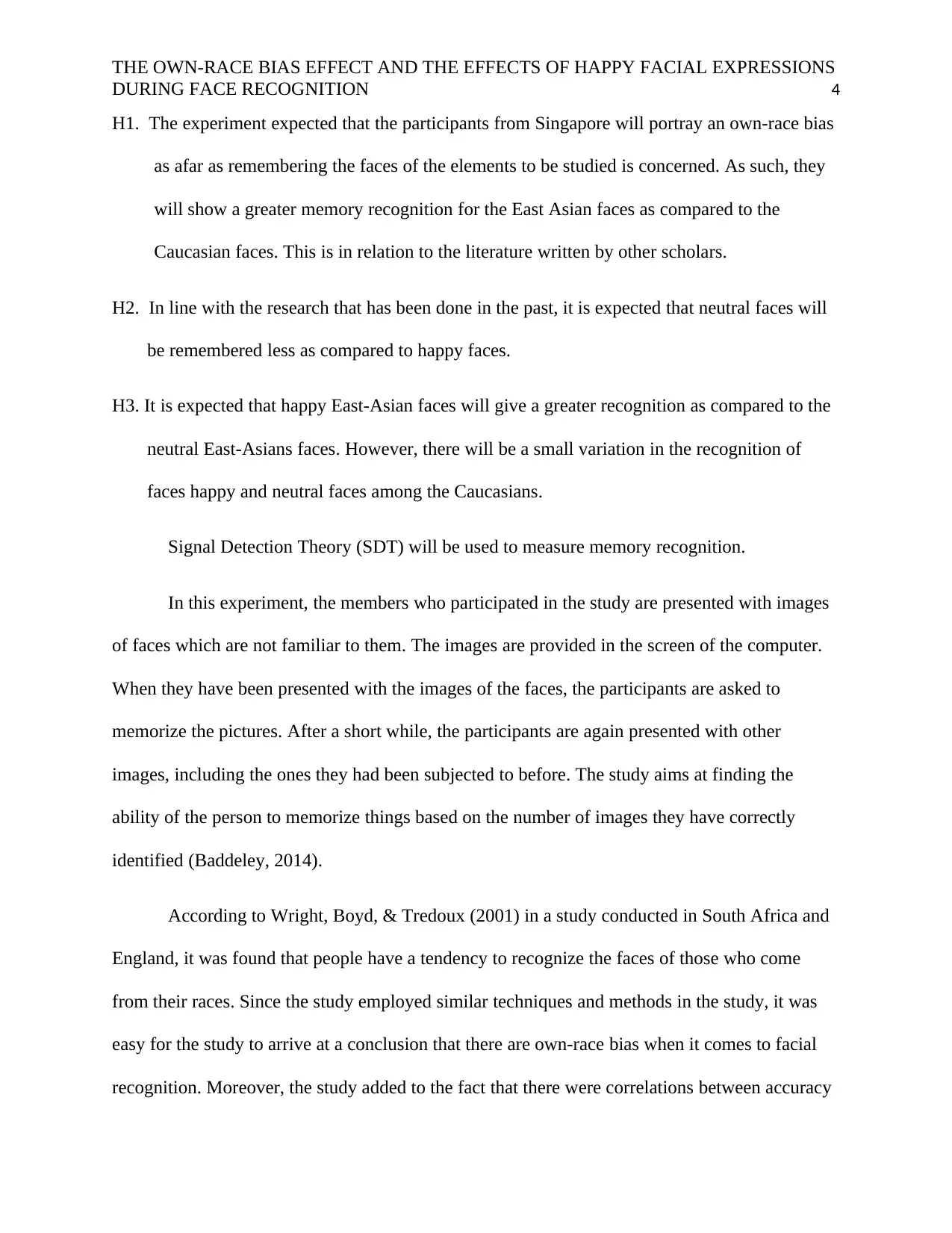
THE OWN-RACE BIAS EFFECT AND THE EFFECTS OF HAPPY FACIAL EXPRESSIONS
DURING FACE RECOGNITION 4
H1. The experiment expected that the participants from Singapore will portray an own-race bias
as afar as remembering the faces of the elements to be studied is concerned. As such, they
will show a greater memory recognition for the East Asian faces as compared to the
Caucasian faces. This is in relation to the literature written by other scholars.
H2. In line with the research that has been done in the past, it is expected that neutral faces will
be remembered less as compared to happy faces.
H3. It is expected that happy East-Asian faces will give a greater recognition as compared to the
neutral East-Asians faces. However, there will be a small variation in the recognition of
faces happy and neutral faces among the Caucasians.
Signal Detection Theory (SDT) will be used to measure memory recognition.
In this experiment, the members who participated in the study are presented with images
of faces which are not familiar to them. The images are provided in the screen of the computer.
When they have been presented with the images of the faces, the participants are asked to
memorize the pictures. After a short while, the participants are again presented with other
images, including the ones they had been subjected to before. The study aims at finding the
ability of the person to memorize things based on the number of images they have correctly
identified (Baddeley, 2014).
According to Wright, Boyd, & Tredoux (2001) in a study conducted in South Africa and
England, it was found that people have a tendency to recognize the faces of those who come
from their races. Since the study employed similar techniques and methods in the study, it was
easy for the study to arrive at a conclusion that there are own-race bias when it comes to facial
recognition. Moreover, the study added to the fact that there were correlations between accuracy
DURING FACE RECOGNITION 4
H1. The experiment expected that the participants from Singapore will portray an own-race bias
as afar as remembering the faces of the elements to be studied is concerned. As such, they
will show a greater memory recognition for the East Asian faces as compared to the
Caucasian faces. This is in relation to the literature written by other scholars.
H2. In line with the research that has been done in the past, it is expected that neutral faces will
be remembered less as compared to happy faces.
H3. It is expected that happy East-Asian faces will give a greater recognition as compared to the
neutral East-Asians faces. However, there will be a small variation in the recognition of
faces happy and neutral faces among the Caucasians.
Signal Detection Theory (SDT) will be used to measure memory recognition.
In this experiment, the members who participated in the study are presented with images
of faces which are not familiar to them. The images are provided in the screen of the computer.
When they have been presented with the images of the faces, the participants are asked to
memorize the pictures. After a short while, the participants are again presented with other
images, including the ones they had been subjected to before. The study aims at finding the
ability of the person to memorize things based on the number of images they have correctly
identified (Baddeley, 2014).
According to Wright, Boyd, & Tredoux (2001) in a study conducted in South Africa and
England, it was found that people have a tendency to recognize the faces of those who come
from their races. Since the study employed similar techniques and methods in the study, it was
easy for the study to arrive at a conclusion that there are own-race bias when it comes to facial
recognition. Moreover, the study added to the fact that there were correlations between accuracy
Secure Best Marks with AI Grader
Need help grading? Try our AI Grader for instant feedback on your assignments.
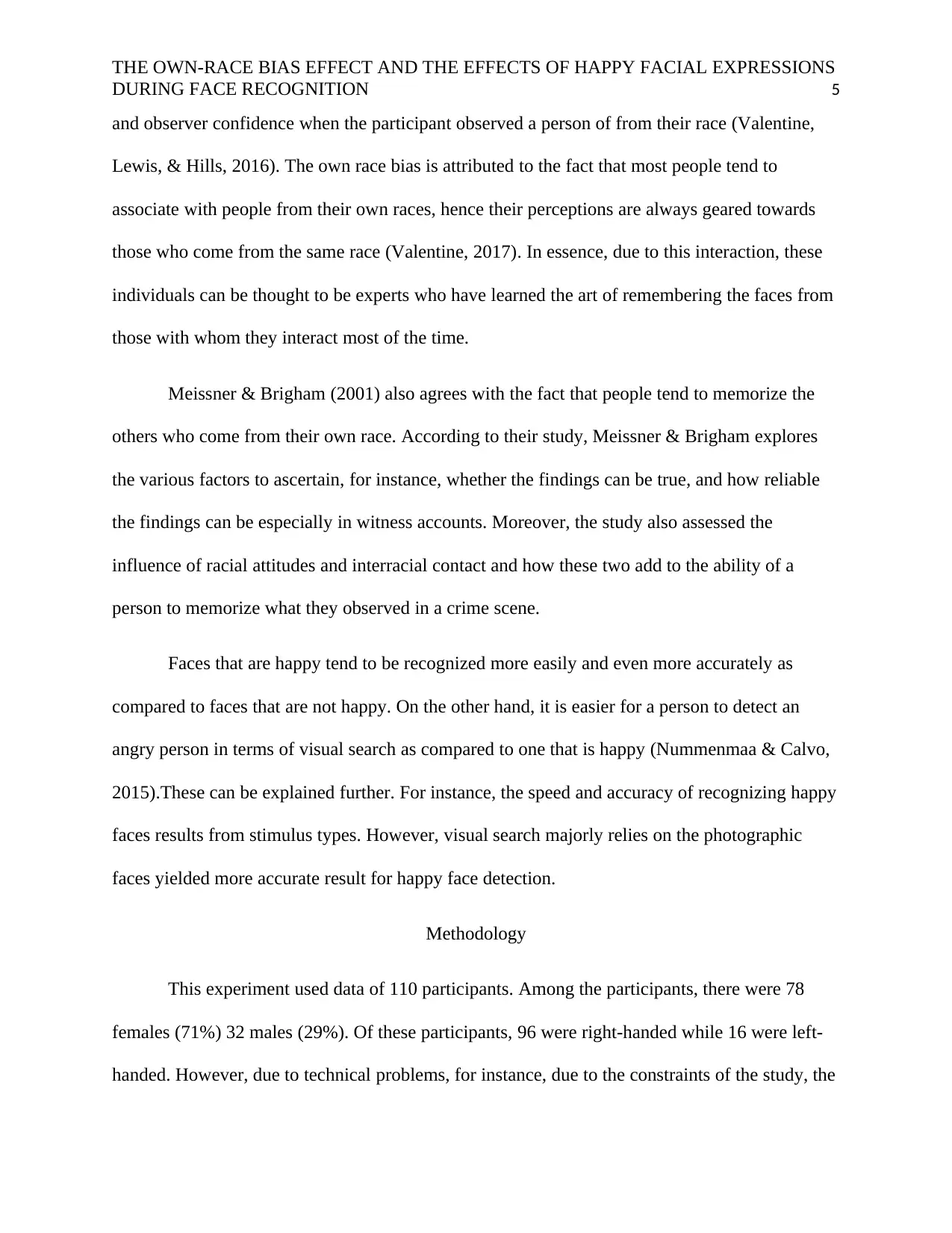
THE OWN-RACE BIAS EFFECT AND THE EFFECTS OF HAPPY FACIAL EXPRESSIONS
DURING FACE RECOGNITION 5
and observer confidence when the participant observed a person of from their race (Valentine,
Lewis, & Hills, 2016). The own race bias is attributed to the fact that most people tend to
associate with people from their own races, hence their perceptions are always geared towards
those who come from the same race (Valentine, 2017). In essence, due to this interaction, these
individuals can be thought to be experts who have learned the art of remembering the faces from
those with whom they interact most of the time.
Meissner & Brigham (2001) also agrees with the fact that people tend to memorize the
others who come from their own race. According to their study, Meissner & Brigham explores
the various factors to ascertain, for instance, whether the findings can be true, and how reliable
the findings can be especially in witness accounts. Moreover, the study also assessed the
influence of racial attitudes and interracial contact and how these two add to the ability of a
person to memorize what they observed in a crime scene.
Faces that are happy tend to be recognized more easily and even more accurately as
compared to faces that are not happy. On the other hand, it is easier for a person to detect an
angry person in terms of visual search as compared to one that is happy (Nummenmaa & Calvo,
2015).These can be explained further. For instance, the speed and accuracy of recognizing happy
faces results from stimulus types. However, visual search majorly relies on the photographic
faces yielded more accurate result for happy face detection.
Methodology
This experiment used data of 110 participants. Among the participants, there were 78
females (71%) 32 males (29%). Of these participants, 96 were right-handed while 16 were left-
handed. However, due to technical problems, for instance, due to the constraints of the study, the
DURING FACE RECOGNITION 5
and observer confidence when the participant observed a person of from their race (Valentine,
Lewis, & Hills, 2016). The own race bias is attributed to the fact that most people tend to
associate with people from their own races, hence their perceptions are always geared towards
those who come from the same race (Valentine, 2017). In essence, due to this interaction, these
individuals can be thought to be experts who have learned the art of remembering the faces from
those with whom they interact most of the time.
Meissner & Brigham (2001) also agrees with the fact that people tend to memorize the
others who come from their own race. According to their study, Meissner & Brigham explores
the various factors to ascertain, for instance, whether the findings can be true, and how reliable
the findings can be especially in witness accounts. Moreover, the study also assessed the
influence of racial attitudes and interracial contact and how these two add to the ability of a
person to memorize what they observed in a crime scene.
Faces that are happy tend to be recognized more easily and even more accurately as
compared to faces that are not happy. On the other hand, it is easier for a person to detect an
angry person in terms of visual search as compared to one that is happy (Nummenmaa & Calvo,
2015).These can be explained further. For instance, the speed and accuracy of recognizing happy
faces results from stimulus types. However, visual search majorly relies on the photographic
faces yielded more accurate result for happy face detection.
Methodology
This experiment used data of 110 participants. Among the participants, there were 78
females (71%) 32 males (29%). Of these participants, 96 were right-handed while 16 were left-
handed. However, due to technical problems, for instance, due to the constraints of the study, the
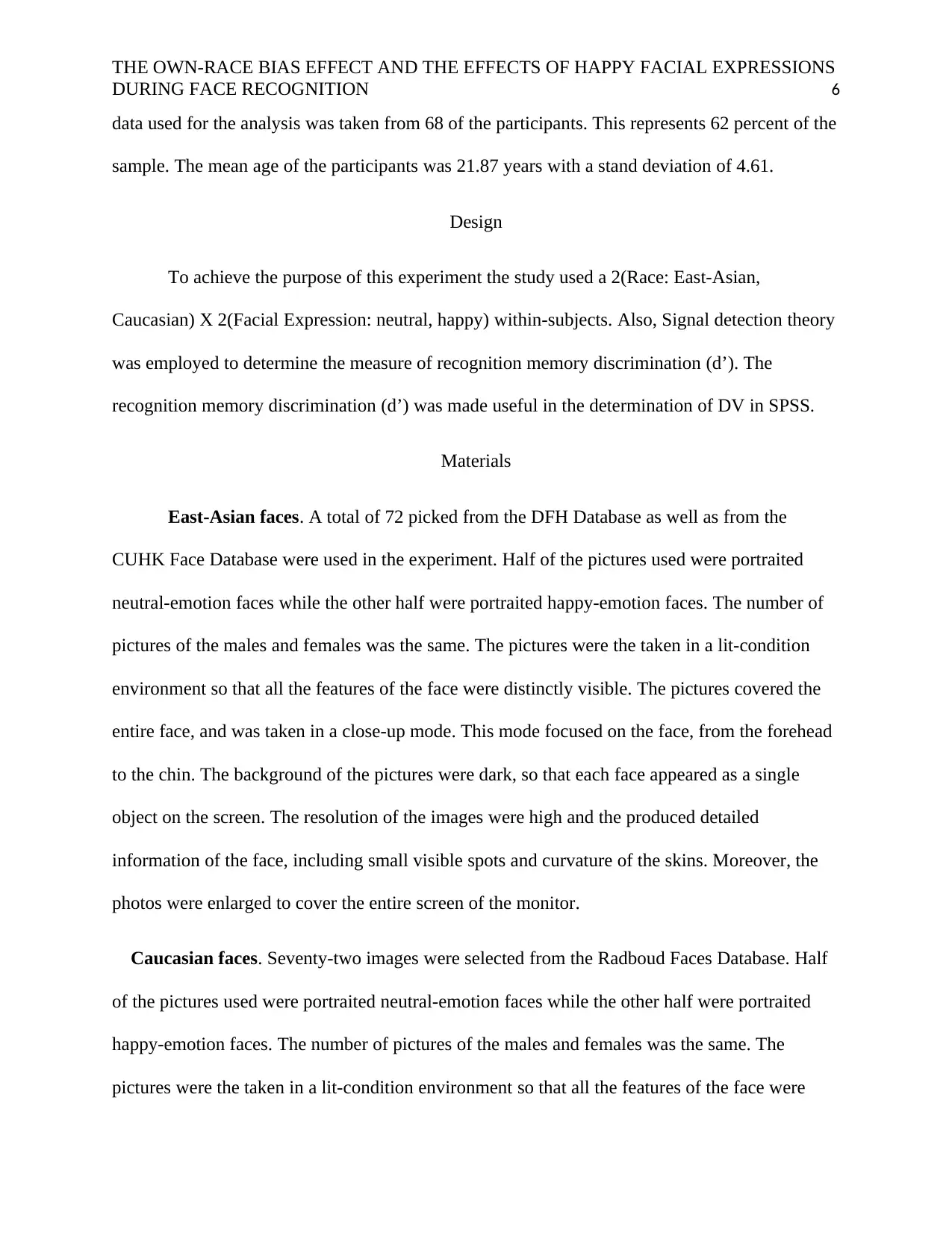
THE OWN-RACE BIAS EFFECT AND THE EFFECTS OF HAPPY FACIAL EXPRESSIONS
DURING FACE RECOGNITION 6
data used for the analysis was taken from 68 of the participants. This represents 62 percent of the
sample. The mean age of the participants was 21.87 years with a stand deviation of 4.61.
Design
To achieve the purpose of this experiment the study used a 2(Race: East-Asian,
Caucasian) X 2(Facial Expression: neutral, happy) within-subjects. Also, Signal detection theory
was employed to determine the measure of recognition memory discrimination (d’). The
recognition memory discrimination (d’) was made useful in the determination of DV in SPSS.
Materials
East-Asian faces. A total of 72 picked from the DFH Database as well as from the
CUHK Face Database were used in the experiment. Half of the pictures used were portraited
neutral-emotion faces while the other half were portraited happy-emotion faces. The number of
pictures of the males and females was the same. The pictures were the taken in a lit-condition
environment so that all the features of the face were distinctly visible. The pictures covered the
entire face, and was taken in a close-up mode. This mode focused on the face, from the forehead
to the chin. The background of the pictures were dark, so that each face appeared as a single
object on the screen. The resolution of the images were high and the produced detailed
information of the face, including small visible spots and curvature of the skins. Moreover, the
photos were enlarged to cover the entire screen of the monitor.
Caucasian faces. Seventy-two images were selected from the Radboud Faces Database. Half
of the pictures used were portraited neutral-emotion faces while the other half were portraited
happy-emotion faces. The number of pictures of the males and females was the same. The
pictures were the taken in a lit-condition environment so that all the features of the face were
DURING FACE RECOGNITION 6
data used for the analysis was taken from 68 of the participants. This represents 62 percent of the
sample. The mean age of the participants was 21.87 years with a stand deviation of 4.61.
Design
To achieve the purpose of this experiment the study used a 2(Race: East-Asian,
Caucasian) X 2(Facial Expression: neutral, happy) within-subjects. Also, Signal detection theory
was employed to determine the measure of recognition memory discrimination (d’). The
recognition memory discrimination (d’) was made useful in the determination of DV in SPSS.
Materials
East-Asian faces. A total of 72 picked from the DFH Database as well as from the
CUHK Face Database were used in the experiment. Half of the pictures used were portraited
neutral-emotion faces while the other half were portraited happy-emotion faces. The number of
pictures of the males and females was the same. The pictures were the taken in a lit-condition
environment so that all the features of the face were distinctly visible. The pictures covered the
entire face, and was taken in a close-up mode. This mode focused on the face, from the forehead
to the chin. The background of the pictures were dark, so that each face appeared as a single
object on the screen. The resolution of the images were high and the produced detailed
information of the face, including small visible spots and curvature of the skins. Moreover, the
photos were enlarged to cover the entire screen of the monitor.
Caucasian faces. Seventy-two images were selected from the Radboud Faces Database. Half
of the pictures used were portraited neutral-emotion faces while the other half were portraited
happy-emotion faces. The number of pictures of the males and females was the same. The
pictures were the taken in a lit-condition environment so that all the features of the face were
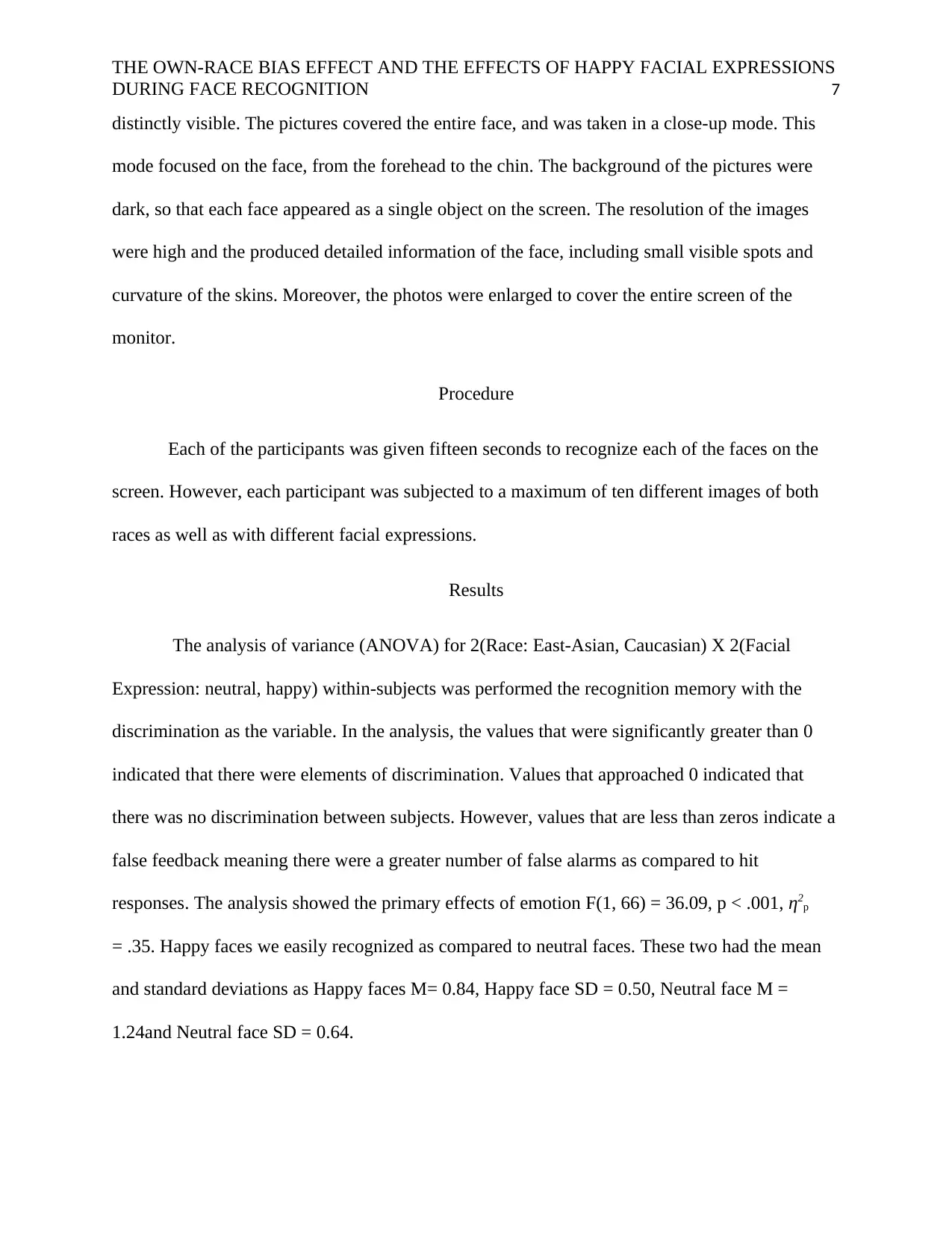
THE OWN-RACE BIAS EFFECT AND THE EFFECTS OF HAPPY FACIAL EXPRESSIONS
DURING FACE RECOGNITION 7
distinctly visible. The pictures covered the entire face, and was taken in a close-up mode. This
mode focused on the face, from the forehead to the chin. The background of the pictures were
dark, so that each face appeared as a single object on the screen. The resolution of the images
were high and the produced detailed information of the face, including small visible spots and
curvature of the skins. Moreover, the photos were enlarged to cover the entire screen of the
monitor.
Procedure
Each of the participants was given fifteen seconds to recognize each of the faces on the
screen. However, each participant was subjected to a maximum of ten different images of both
races as well as with different facial expressions.
Results
The analysis of variance (ANOVA) for 2(Race: East-Asian, Caucasian) X 2(Facial
Expression: neutral, happy) within-subjects was performed the recognition memory with the
discrimination as the variable. In the analysis, the values that were significantly greater than 0
indicated that there were elements of discrimination. Values that approached 0 indicated that
there was no discrimination between subjects. However, values that are less than zeros indicate a
false feedback meaning there were a greater number of false alarms as compared to hit
responses. The analysis showed the primary effects of emotion F(1, 66) = 36.09, p < .001, η2p
= .35. Happy faces we easily recognized as compared to neutral faces. These two had the mean
and standard deviations as Happy faces M= 0.84, Happy face SD = 0.50, Neutral face M =
1.24and Neutral face SD = 0.64.
DURING FACE RECOGNITION 7
distinctly visible. The pictures covered the entire face, and was taken in a close-up mode. This
mode focused on the face, from the forehead to the chin. The background of the pictures were
dark, so that each face appeared as a single object on the screen. The resolution of the images
were high and the produced detailed information of the face, including small visible spots and
curvature of the skins. Moreover, the photos were enlarged to cover the entire screen of the
monitor.
Procedure
Each of the participants was given fifteen seconds to recognize each of the faces on the
screen. However, each participant was subjected to a maximum of ten different images of both
races as well as with different facial expressions.
Results
The analysis of variance (ANOVA) for 2(Race: East-Asian, Caucasian) X 2(Facial
Expression: neutral, happy) within-subjects was performed the recognition memory with the
discrimination as the variable. In the analysis, the values that were significantly greater than 0
indicated that there were elements of discrimination. Values that approached 0 indicated that
there was no discrimination between subjects. However, values that are less than zeros indicate a
false feedback meaning there were a greater number of false alarms as compared to hit
responses. The analysis showed the primary effects of emotion F(1, 66) = 36.09, p < .001, η2p
= .35. Happy faces we easily recognized as compared to neutral faces. These two had the mean
and standard deviations as Happy faces M= 0.84, Happy face SD = 0.50, Neutral face M =
1.24and Neutral face SD = 0.64.
Paraphrase This Document
Need a fresh take? Get an instant paraphrase of this document with our AI Paraphraser
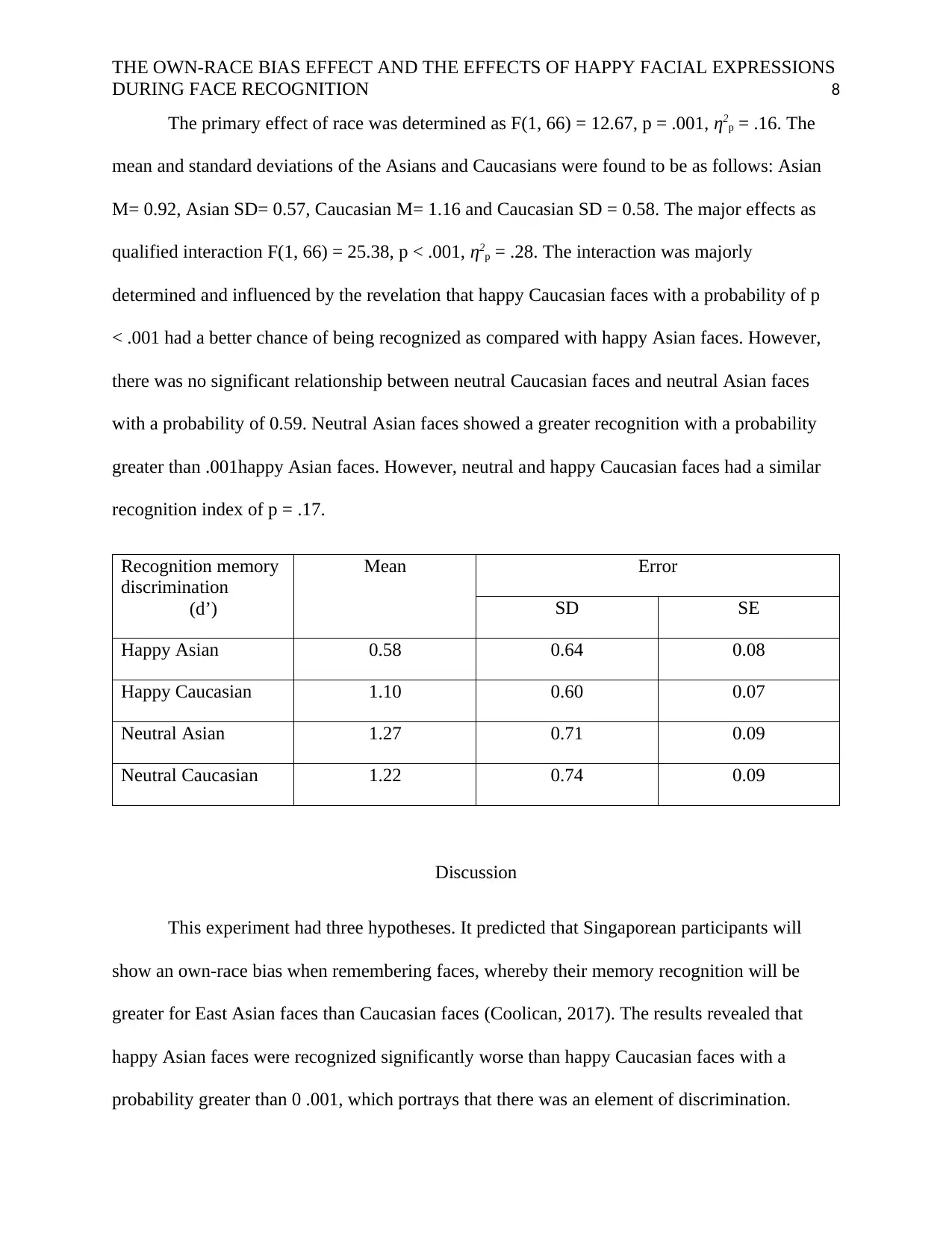
THE OWN-RACE BIAS EFFECT AND THE EFFECTS OF HAPPY FACIAL EXPRESSIONS
DURING FACE RECOGNITION 8
The primary effect of race was determined as F(1, 66) = 12.67, p = .001, η2p = .16. The
mean and standard deviations of the Asians and Caucasians were found to be as follows: Asian
M= 0.92, Asian SD= 0.57, Caucasian M= 1.16 and Caucasian SD = 0.58. The major effects as
qualified interaction F(1, 66) = 25.38, p < .001, η2p = .28. The interaction was majorly
determined and influenced by the revelation that happy Caucasian faces with a probability of p
< .001 had a better chance of being recognized as compared with happy Asian faces. However,
there was no significant relationship between neutral Caucasian faces and neutral Asian faces
with a probability of 0.59. Neutral Asian faces showed a greater recognition with a probability
greater than .001happy Asian faces. However, neutral and happy Caucasian faces had a similar
recognition index of p = .17.
Recognition memory
discrimination
(d’)
Mean Error
SD SE
Happy Asian 0.58 0.64 0.08
Happy Caucasian 1.10 0.60 0.07
Neutral Asian 1.27 0.71 0.09
Neutral Caucasian 1.22 0.74 0.09
Discussion
This experiment had three hypotheses. It predicted that Singaporean participants will
show an own-race bias when remembering faces, whereby their memory recognition will be
greater for East Asian faces than Caucasian faces (Coolican, 2017). The results revealed that
happy Asian faces were recognized significantly worse than happy Caucasian faces with a
probability greater than 0 .001, which portrays that there was an element of discrimination.
DURING FACE RECOGNITION 8
The primary effect of race was determined as F(1, 66) = 12.67, p = .001, η2p = .16. The
mean and standard deviations of the Asians and Caucasians were found to be as follows: Asian
M= 0.92, Asian SD= 0.57, Caucasian M= 1.16 and Caucasian SD = 0.58. The major effects as
qualified interaction F(1, 66) = 25.38, p < .001, η2p = .28. The interaction was majorly
determined and influenced by the revelation that happy Caucasian faces with a probability of p
< .001 had a better chance of being recognized as compared with happy Asian faces. However,
there was no significant relationship between neutral Caucasian faces and neutral Asian faces
with a probability of 0.59. Neutral Asian faces showed a greater recognition with a probability
greater than .001happy Asian faces. However, neutral and happy Caucasian faces had a similar
recognition index of p = .17.
Recognition memory
discrimination
(d’)
Mean Error
SD SE
Happy Asian 0.58 0.64 0.08
Happy Caucasian 1.10 0.60 0.07
Neutral Asian 1.27 0.71 0.09
Neutral Caucasian 1.22 0.74 0.09
Discussion
This experiment had three hypotheses. It predicted that Singaporean participants will
show an own-race bias when remembering faces, whereby their memory recognition will be
greater for East Asian faces than Caucasian faces (Coolican, 2017). The results revealed that
happy Asian faces were recognized significantly worse than happy Caucasian faces with a
probability greater than 0 .001, which portrays that there was an element of discrimination.
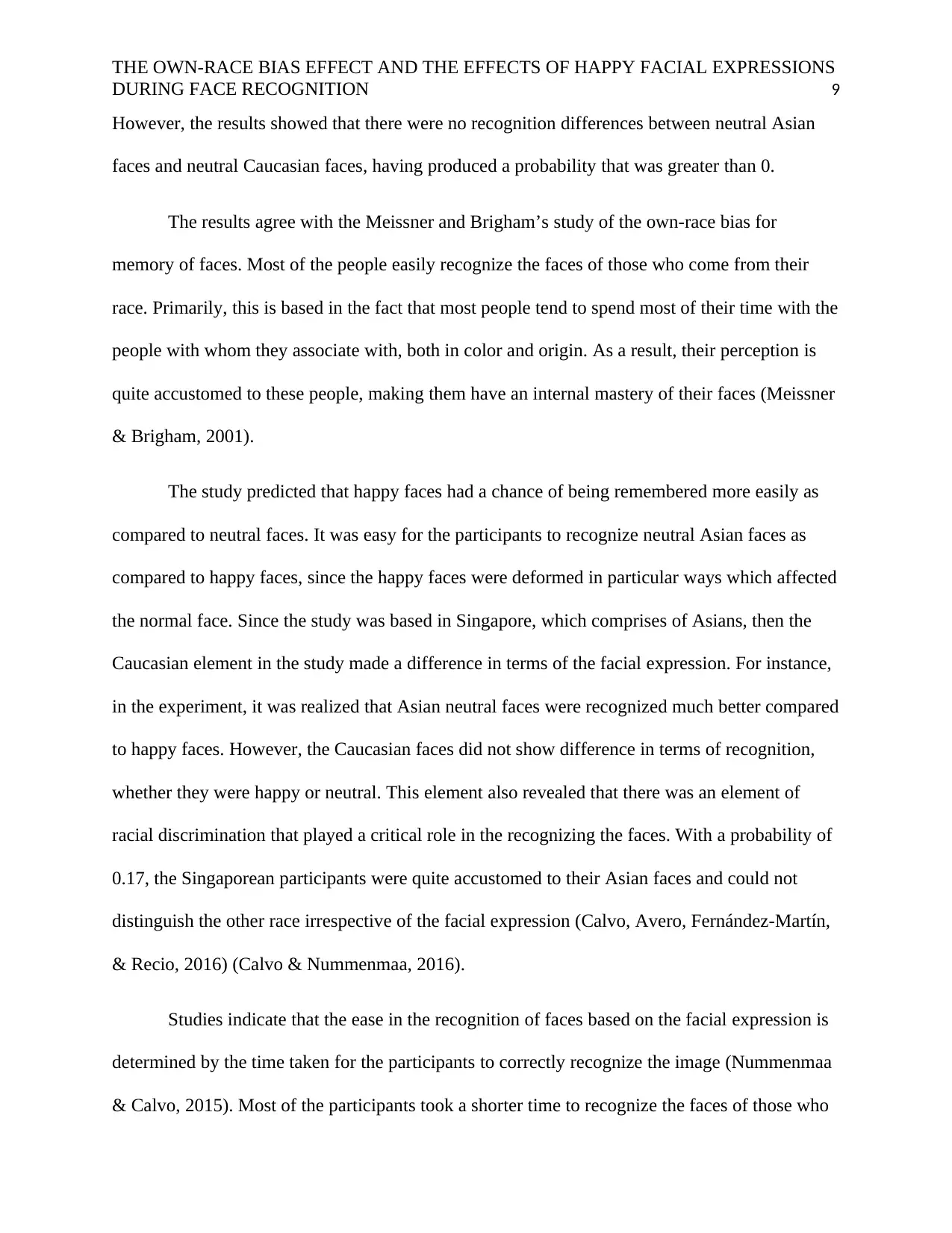
THE OWN-RACE BIAS EFFECT AND THE EFFECTS OF HAPPY FACIAL EXPRESSIONS
DURING FACE RECOGNITION 9
However, the results showed that there were no recognition differences between neutral Asian
faces and neutral Caucasian faces, having produced a probability that was greater than 0.
The results agree with the Meissner and Brigham’s study of the own-race bias for
memory of faces. Most of the people easily recognize the faces of those who come from their
race. Primarily, this is based in the fact that most people tend to spend most of their time with the
people with whom they associate with, both in color and origin. As a result, their perception is
quite accustomed to these people, making them have an internal mastery of their faces (Meissner
& Brigham, 2001).
The study predicted that happy faces had a chance of being remembered more easily as
compared to neutral faces. It was easy for the participants to recognize neutral Asian faces as
compared to happy faces, since the happy faces were deformed in particular ways which affected
the normal face. Since the study was based in Singapore, which comprises of Asians, then the
Caucasian element in the study made a difference in terms of the facial expression. For instance,
in the experiment, it was realized that Asian neutral faces were recognized much better compared
to happy faces. However, the Caucasian faces did not show difference in terms of recognition,
whether they were happy or neutral. This element also revealed that there was an element of
racial discrimination that played a critical role in the recognizing the faces. With a probability of
0.17, the Singaporean participants were quite accustomed to their Asian faces and could not
distinguish the other race irrespective of the facial expression (Calvo, Avero, Fernández-Martín,
& Recio, 2016) (Calvo & Nummenmaa, 2016).
Studies indicate that the ease in the recognition of faces based on the facial expression is
determined by the time taken for the participants to correctly recognize the image (Nummenmaa
& Calvo, 2015). Most of the participants took a shorter time to recognize the faces of those who
DURING FACE RECOGNITION 9
However, the results showed that there were no recognition differences between neutral Asian
faces and neutral Caucasian faces, having produced a probability that was greater than 0.
The results agree with the Meissner and Brigham’s study of the own-race bias for
memory of faces. Most of the people easily recognize the faces of those who come from their
race. Primarily, this is based in the fact that most people tend to spend most of their time with the
people with whom they associate with, both in color and origin. As a result, their perception is
quite accustomed to these people, making them have an internal mastery of their faces (Meissner
& Brigham, 2001).
The study predicted that happy faces had a chance of being remembered more easily as
compared to neutral faces. It was easy for the participants to recognize neutral Asian faces as
compared to happy faces, since the happy faces were deformed in particular ways which affected
the normal face. Since the study was based in Singapore, which comprises of Asians, then the
Caucasian element in the study made a difference in terms of the facial expression. For instance,
in the experiment, it was realized that Asian neutral faces were recognized much better compared
to happy faces. However, the Caucasian faces did not show difference in terms of recognition,
whether they were happy or neutral. This element also revealed that there was an element of
racial discrimination that played a critical role in the recognizing the faces. With a probability of
0.17, the Singaporean participants were quite accustomed to their Asian faces and could not
distinguish the other race irrespective of the facial expression (Calvo, Avero, Fernández-Martín,
& Recio, 2016) (Calvo & Nummenmaa, 2016).
Studies indicate that the ease in the recognition of faces based on the facial expression is
determined by the time taken for the participants to correctly recognize the image (Nummenmaa
& Calvo, 2015). Most of the participants took a shorter time to recognize the faces of those who
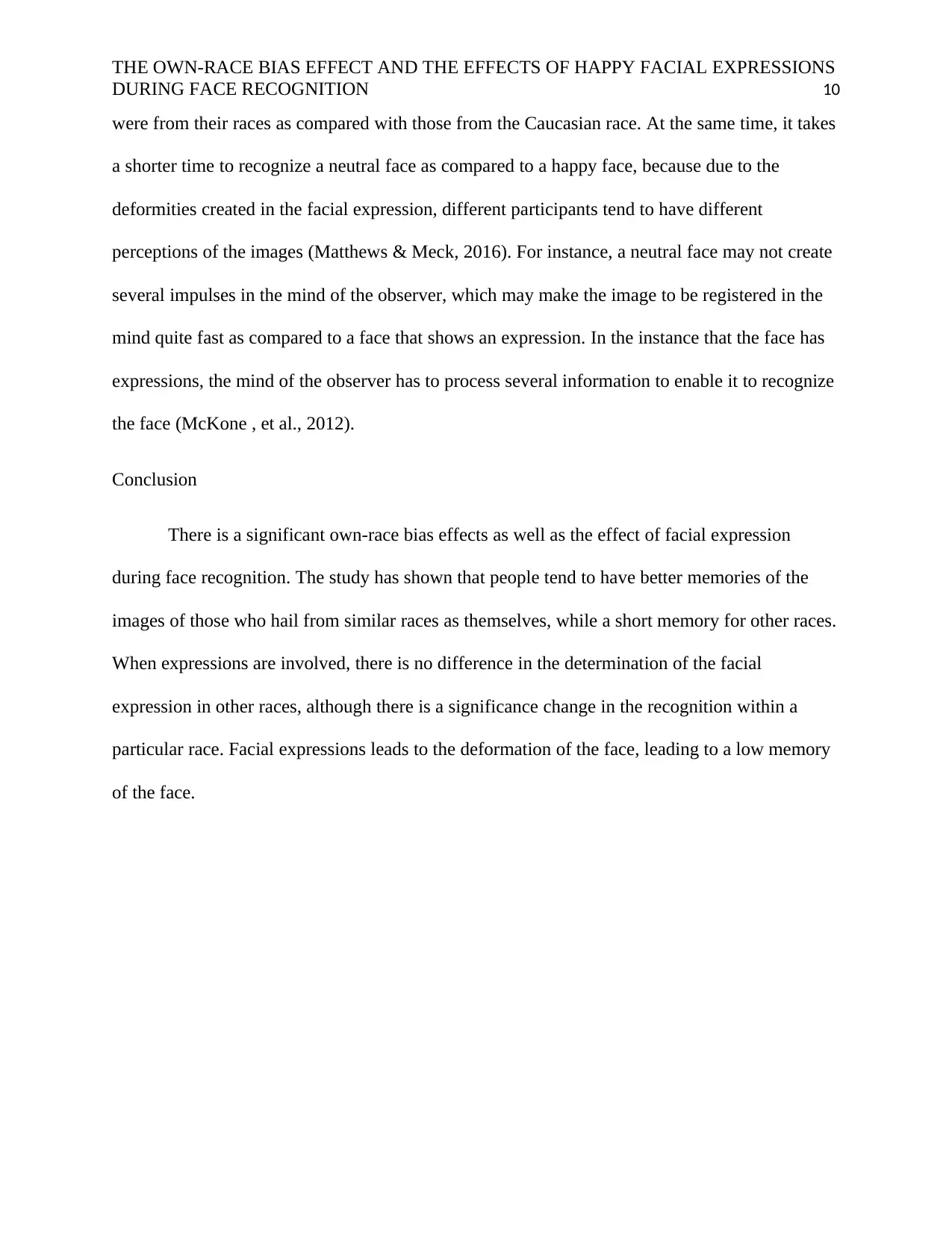
THE OWN-RACE BIAS EFFECT AND THE EFFECTS OF HAPPY FACIAL EXPRESSIONS
DURING FACE RECOGNITION 10
were from their races as compared with those from the Caucasian race. At the same time, it takes
a shorter time to recognize a neutral face as compared to a happy face, because due to the
deformities created in the facial expression, different participants tend to have different
perceptions of the images (Matthews & Meck, 2016). For instance, a neutral face may not create
several impulses in the mind of the observer, which may make the image to be registered in the
mind quite fast as compared to a face that shows an expression. In the instance that the face has
expressions, the mind of the observer has to process several information to enable it to recognize
the face (McKone , et al., 2012).
Conclusion
There is a significant own-race bias effects as well as the effect of facial expression
during face recognition. The study has shown that people tend to have better memories of the
images of those who hail from similar races as themselves, while a short memory for other races.
When expressions are involved, there is no difference in the determination of the facial
expression in other races, although there is a significance change in the recognition within a
particular race. Facial expressions leads to the deformation of the face, leading to a low memory
of the face.
DURING FACE RECOGNITION 10
were from their races as compared with those from the Caucasian race. At the same time, it takes
a shorter time to recognize a neutral face as compared to a happy face, because due to the
deformities created in the facial expression, different participants tend to have different
perceptions of the images (Matthews & Meck, 2016). For instance, a neutral face may not create
several impulses in the mind of the observer, which may make the image to be registered in the
mind quite fast as compared to a face that shows an expression. In the instance that the face has
expressions, the mind of the observer has to process several information to enable it to recognize
the face (McKone , et al., 2012).
Conclusion
There is a significant own-race bias effects as well as the effect of facial expression
during face recognition. The study has shown that people tend to have better memories of the
images of those who hail from similar races as themselves, while a short memory for other races.
When expressions are involved, there is no difference in the determination of the facial
expression in other races, although there is a significance change in the recognition within a
particular race. Facial expressions leads to the deformation of the face, leading to a low memory
of the face.
Secure Best Marks with AI Grader
Need help grading? Try our AI Grader for instant feedback on your assignments.
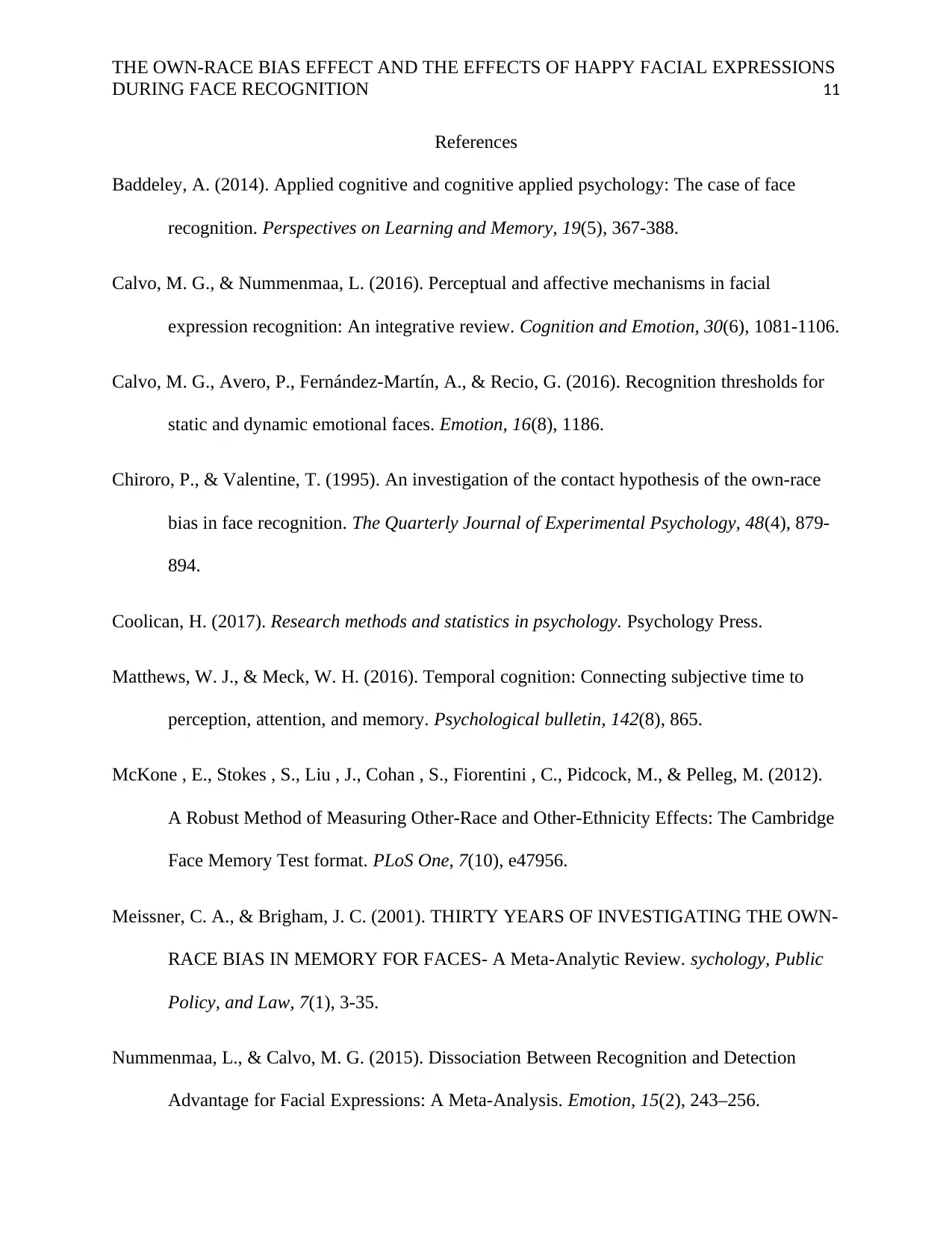
THE OWN-RACE BIAS EFFECT AND THE EFFECTS OF HAPPY FACIAL EXPRESSIONS
DURING FACE RECOGNITION 11
References
Baddeley, A. (2014). Applied cognitive and cognitive applied psychology: The case of face
recognition. Perspectives on Learning and Memory, 19(5), 367-388.
Calvo, M. G., & Nummenmaa, L. (2016). Perceptual and affective mechanisms in facial
expression recognition: An integrative review. Cognition and Emotion, 30(6), 1081-1106.
Calvo, M. G., Avero, P., Fernández-Martín, A., & Recio, G. (2016). Recognition thresholds for
static and dynamic emotional faces. Emotion, 16(8), 1186.
Chiroro, P., & Valentine, T. (1995). An investigation of the contact hypothesis of the own-race
bias in face recognition. The Quarterly Journal of Experimental Psychology, 48(4), 879-
894.
Coolican, H. (2017). Research methods and statistics in psychology. Psychology Press.
Matthews, W. J., & Meck, W. H. (2016). Temporal cognition: Connecting subjective time to
perception, attention, and memory. Psychological bulletin, 142(8), 865.
McKone , E., Stokes , S., Liu , J., Cohan , S., Fiorentini , C., Pidcock, M., & Pelleg, M. (2012).
A Robust Method of Measuring Other-Race and Other-Ethnicity Effects: The Cambridge
Face Memory Test format. PLoS One, 7(10), e47956.
Meissner, C. A., & Brigham, J. C. (2001). THIRTY YEARS OF INVESTIGATING THE OWN-
RACE BIAS IN MEMORY FOR FACES- A Meta-Analytic Review. sychology, Public
Policy, and Law, 7(1), 3-35.
Nummenmaa, L., & Calvo, M. G. (2015). Dissociation Between Recognition and Detection
Advantage for Facial Expressions: A Meta-Analysis. Emotion, 15(2), 243–256.
DURING FACE RECOGNITION 11
References
Baddeley, A. (2014). Applied cognitive and cognitive applied psychology: The case of face
recognition. Perspectives on Learning and Memory, 19(5), 367-388.
Calvo, M. G., & Nummenmaa, L. (2016). Perceptual and affective mechanisms in facial
expression recognition: An integrative review. Cognition and Emotion, 30(6), 1081-1106.
Calvo, M. G., Avero, P., Fernández-Martín, A., & Recio, G. (2016). Recognition thresholds for
static and dynamic emotional faces. Emotion, 16(8), 1186.
Chiroro, P., & Valentine, T. (1995). An investigation of the contact hypothesis of the own-race
bias in face recognition. The Quarterly Journal of Experimental Psychology, 48(4), 879-
894.
Coolican, H. (2017). Research methods and statistics in psychology. Psychology Press.
Matthews, W. J., & Meck, W. H. (2016). Temporal cognition: Connecting subjective time to
perception, attention, and memory. Psychological bulletin, 142(8), 865.
McKone , E., Stokes , S., Liu , J., Cohan , S., Fiorentini , C., Pidcock, M., & Pelleg, M. (2012).
A Robust Method of Measuring Other-Race and Other-Ethnicity Effects: The Cambridge
Face Memory Test format. PLoS One, 7(10), e47956.
Meissner, C. A., & Brigham, J. C. (2001). THIRTY YEARS OF INVESTIGATING THE OWN-
RACE BIAS IN MEMORY FOR FACES- A Meta-Analytic Review. sychology, Public
Policy, and Law, 7(1), 3-35.
Nummenmaa, L., & Calvo, M. G. (2015). Dissociation Between Recognition and Detection
Advantage for Facial Expressions: A Meta-Analysis. Emotion, 15(2), 243–256.
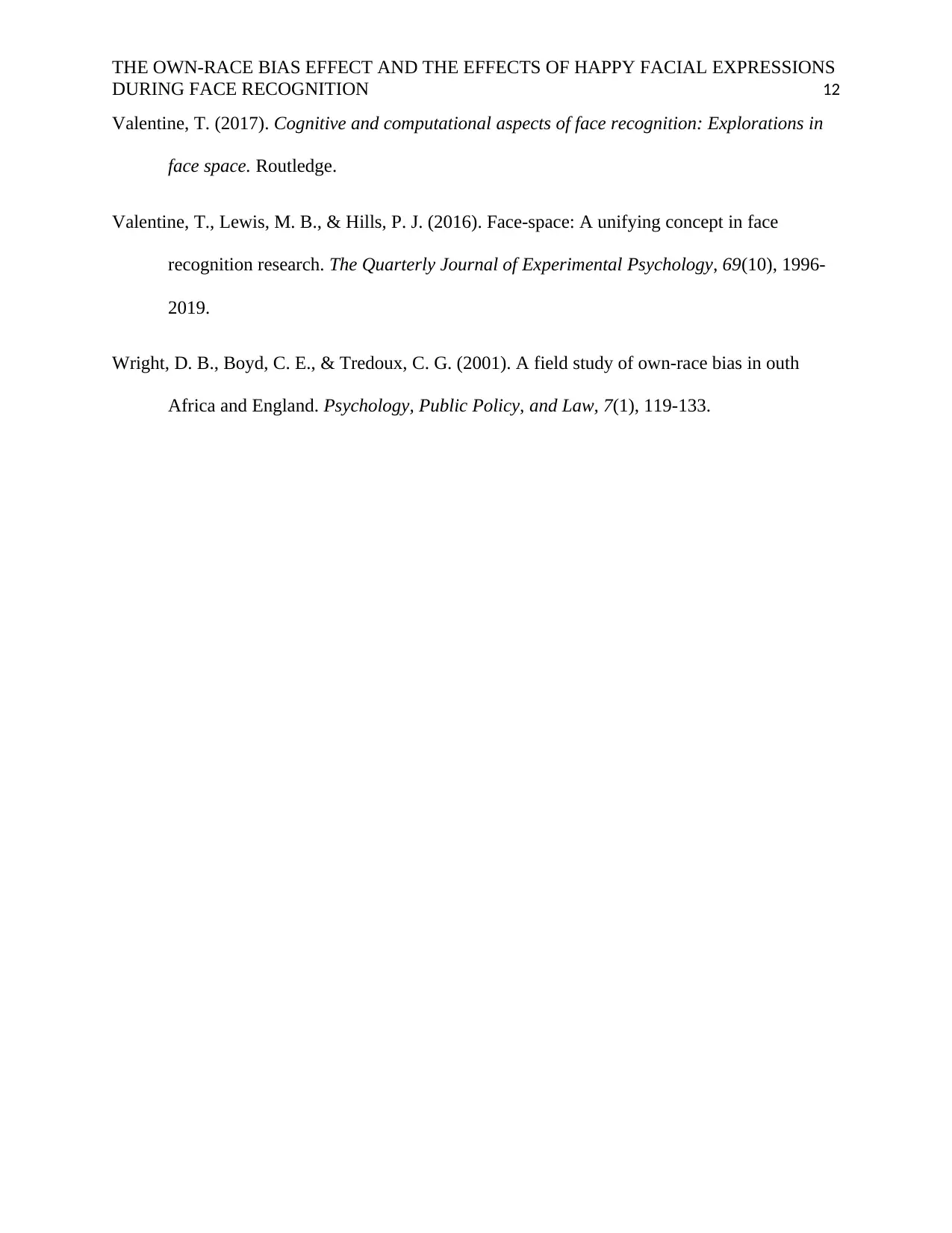
THE OWN-RACE BIAS EFFECT AND THE EFFECTS OF HAPPY FACIAL EXPRESSIONS
DURING FACE RECOGNITION 12
Valentine, T. (2017). Cognitive and computational aspects of face recognition: Explorations in
face space. Routledge.
Valentine, T., Lewis, M. B., & Hills, P. J. (2016). Face-space: A unifying concept in face
recognition research. The Quarterly Journal of Experimental Psychology, 69(10), 1996-
2019.
Wright, D. B., Boyd, C. E., & Tredoux, C. G. (2001). A field study of own-race bias in outh
Africa and England. Psychology, Public Policy, and Law, 7(1), 119-133.
DURING FACE RECOGNITION 12
Valentine, T. (2017). Cognitive and computational aspects of face recognition: Explorations in
face space. Routledge.
Valentine, T., Lewis, M. B., & Hills, P. J. (2016). Face-space: A unifying concept in face
recognition research. The Quarterly Journal of Experimental Psychology, 69(10), 1996-
2019.
Wright, D. B., Boyd, C. E., & Tredoux, C. G. (2001). A field study of own-race bias in outh
Africa and England. Psychology, Public Policy, and Law, 7(1), 119-133.
1 out of 12
Your All-in-One AI-Powered Toolkit for Academic Success.
+13062052269
info@desklib.com
Available 24*7 on WhatsApp / Email
![[object Object]](/_next/static/media/star-bottom.7253800d.svg)
Unlock your academic potential
© 2024 | Zucol Services PVT LTD | All rights reserved.
